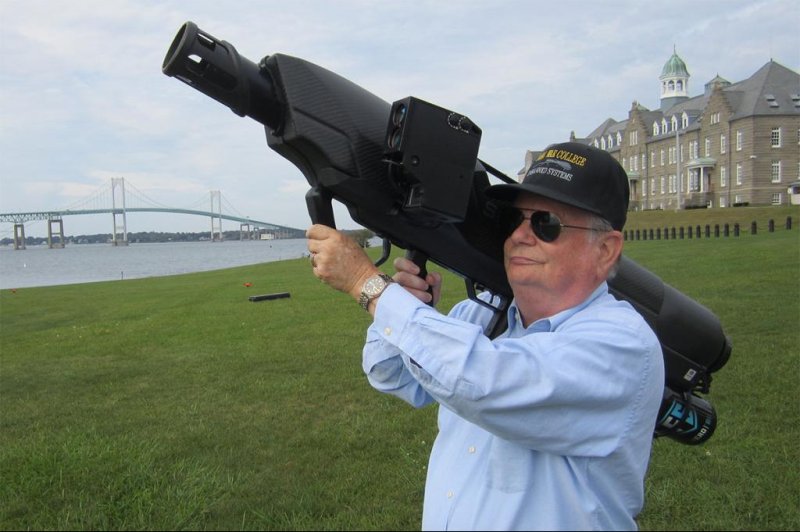The SkyWall-100, developed by British-based OpenWorks Engineering, is a hand-held anti-drone gun that launches a projectile at the target and captures it by deploying a net and parachute to bring the drone safely back to earth. Photo courtesy of Ret. U.S. Navy Capt. John E. Jackson
Feb. 5 (UPI) -- With every report of an airport intrusion or an airborne near-miss with a flying drone, I fear that a follow-up story will soon detail the tragic results of a large-scale disaster caused by the collision of a drone and a commercial aircraft.
In recent weeks, Newark Liberty Airport was forced to suspend operations for a period of time following reports of nearby drone activity. In December, 140,000 passengers and over 1,000 flights were impacted by reports of drones in the area of England's Gatwick Airport. While no confirmed drone/aircraft collisions have occurred, the threat is real and the potential for disaster is ever present.
Aggressive action taken now could help minimize the likelihood of such events, but will require coordinated effort by public and private entities. The data on drone events around the world indicate that they fall into three basic categories, some of which are more easily addressed than others. First, many events occur due to the lack of awareness by hobbyists and casual operators of the potential seriousness of their actions. Secondly, some instances can be attributed to shortcomings in the hardware and software embedded in the aircraft and their controllers. Thirdly, and the most difficult to counter, are events that are purposeful and driven by malicious intent.
In the first case, we need a dedicated campaign of public education through the media, in our schools and through the membership of clubs and organizations with an interest in aviation and aviation safety. Many ill-informed fledgling drone pilots simply un-box their new quadrotor drones, toss out any instructions provided by the manufacturer and fling the mini-aircraft into the sky with little forethought about the potential consequences.
An education campaign would use public service announcements, focused lesson plans for use in schools, and celebrity messages on social media platforms to reach the target audience of tech-savvy users. At the local community level, designated drone "free-fly" zones and parks could be established and promoted as places where the growing hobby can be safely practiced. The Academy of Model Aeronautics has been active for more than 80 years and has a membership in excess of 195,000. It works to ensure that radio-controlled aircraft of all types are operated in a responsible manner. The AMA is expanding its reach to support the explosion of drone hobbyists, and could be a strong partner in efforts to address concerns about uncontrolled drone usage.
Pressure should be brought to bear on manufacturers to ensure that technology, such as geo-fencing, is installed in every device marketed in the United States. Chinese manufacturer DJI, which accounts for nearly 74 percent of the drones manufactured worldwide, has led the effort by installing software (called GEO, for Geospatial Environment Online) that limits the ability of their drones to fly into restricted airspace. Such efforts should be mandatory for any drones sold and operated in the United States, and federal consumer protection efforts should prevent unsafe drones from being imported.
Third, our airports and municipalities must invest in systems and personnel to protect our airports and large public gatherings where the greatest number of attacks may occur. Many different "counter/anti" unmanned aerial systems devices are being developed, ranging from systems that seek to jam a drone's control signals, to clever systems that capture the drone through mechanical means. The SkyWall-100, developed by British-based OpenWorks Engineering, is a hand-held anti-drone gun that launches a projectile at the target and captures it by deploying a net and parachute to bring the drone safely back to earth. This kinetic approach protects people and equipment on the ground, and enables first responders to perform forensics on the device to help prevent future attacks.
Airborne capture systems, such as the Interceptor by Airspace Systems, utilize a net-capture approach by carrying a package on a flying drone that is vectored to the vicinity of the target to snag the drone and safely fly it away from the intended target. Many other systems are in development including the use of trained hawks to intercept wayward drones. For a relatively small investment, every airport in the country and every large-venue operator could achieve a high degree of protection. In times of increased threat, perhaps volunteers from groups such as the Civil Air Patrol could provide runway observers to alert authorities to the presence of potentially hostile drones. The cost of prevention will be minimal when weighed against the human and monetary costs of even a single incident.
On countless occasions over recent years, experts have bemoaned the fact that "it is just a matter of time" before a drone disaster occurs near our nation's airports or over some packed sports arena or outdoor event venue. We need a national "call to arms" to take action today to avoid a disaster tomorrow. The threat is real, and positive steps can be taken to mitigate some of the risk. We owe our citizens a safe environment in which to travel, work and play. Deterring drone disasters must become a priority issue across the nation.
Ret. U.S. Navy Capt. John E. Jackson, who holds the E.A. Sperry Chair of Unmanned and Robotic Systems at the U.S. Naval War College, is the editor of "One Nation, Under Drones " published by the U.S. Naval Institute Press.















